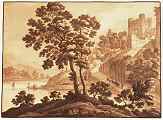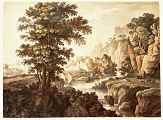|
||||||||||||||||||||||||||||||||
|
According to John Clerk of Eldin, Robert Adam's ambition, before joining his father William Adam's firm, was to be a landscape painter. While studying at Edinburgh University between the ages of 15 ands 17, he had "very sedulously occupied his leisure hours" at the college in sketching landscapes.1 The only surviving examples of these youthful efforts are some pen-and-ink copies of engravings after Salvator Rosa and other fashionable Old Masters. These have been described as "rather clumsy in handling though interesting as indications of a taste for the romantic and picturesque which was to remain an important though often repressed element in his style as an architect."2 Salvatore Rosa's scenes included wild landscapes with ruins and darkly imaginative themes, which seem to have appealed to the 18th century imagination. While working on the construction of Fort George for his father the architect William Adam between 1749 and 1754, Robert Adam met and become friendly with Paul Sandby (1730-1809), a surveyor and talented draftsman, who spent much of his free time painting landscapes. His topographically accurate scenes are now well known. They had a great impact on Robert and the two became friends and painting companions. There are a number of sketches and watercolours by both from the same viewpoint. Another friend and painting and sketching companion was John Clerk of Eldin, who was also his brother-in-law and wrote a biography of Robert. Paintings of all three are usually from picturesque viewpoints, and contain many of the components of the fantasy compositions that Robert Adam continued to create for most of his life, ruined castles, cliffs, rivers and gorges. In Robert's paintings these elements are generally in strong dramatic light and various techniques are used to give them great depth.3 Adam continued painting picturesque scenes like these almost all his life. In many, the foregrounds and middle distance have the stylised quality of eighteenth century paintings, particularly the trees and rock faces. There is a striking similarity between his technique for drawing trees, and that of his painting teacher while on his Grand Tour in Italy, Charles-Louis Clerisseau. The backgrounds of these picturesque scenes, the far distance, is sketched more freely and often look very like Scottish mountain scenery. He produced a prodigious number of these watercolour paintings which he apparently kept in carefully numbered sets arranged in special albums.4 Many are now lost. He knew to them to be of value both as works of art and in the sale rooms. In 1774 Robert and James Adam's business was nearly ruined as a result of a poor speculation - the development of a mixed housing and warehousing development in London called the Adelphi. His problems were compounded by the sudden collapse of the Scottish Banking system. At this critical juncture he gave 1000 of his "picturesque fantasies" to his sisters, so that if the financial problems did lead to bankruptcy, they would have something of value to sell to support themselves. In fact Adam's picturesque compositions may have been more widely known in his own day than they are now. On his death in 1792, his obituary in The Gentleman's Magazine stated "His talents extended beyond the line of his own profession; he displayed in his numerous drawings in landscape a luxuriance of composition, and an effect of light and shadow, that has scarce ever been equalled".
Influence of the Picturesque Compositions on the Castle Style.
It is also interesting to consider whether for Adam these paintings are landscapes that include imaginary castles as part of their composition, or whether the paintings are a medium to allow him to fantasise about, extend and devise new architectural forms, untrammelled by real considerations such as client, budget, or an actual site. Certainly the castle designs include experimental architectural forms. However, as paintings they also hold together. Adam uses a number of techniques to structure the paintings. In particular he makes considerable use of chirascuro effects, light and dark, to add drama and often uses dramatic slanting sunbursts of light to great effect. He also uses the technique of using a screen of foliage to create distance from the viewer, thereby giving depth to the painting and directing the eye at the parts beyond in a controlled way. The scenes are quite controlled; structured and stage managed. In this way they might be considered to be "architectural". The paintings also tell us a story. In part the story seems to be about bucolic pastoral peasant life as painted in many a classical scene, though Adam does seem to have added some elements of wry humour, that may have to do with observations from real life...for example in Fig. 1, the man in the cart making his wife walk up the hill, and in Fig. 2. at least one of the sheep looks about to fall into the river, while the shepherdess, oblivious, talks to the shepherd boy. One striking thing about many of the castles in most of these scenes is their lack of symmetry. When actually designing in the Castle Style Adam generally (with some exceptions) did everything he could to maintain a classical symmetry about the parts. Even in Culzean Castle, cited as being Adams most picturesque castle composition, "echoing the mood of many of his landscape compositions".5 he apparently abandoned symmetry very reluctantly.6 His Castle Style buildings were essentially Classical in spirit. Other influences on both the subject of these paintings and the development of the Castle Style have quite reasonably been cited as the art works that Adam saw on his Grand Tour, as well as the real castles in Germany and Italy, Italian castellated bridges and hill top towns that he saw while travelling. References 1. Fleming, John. Robert Adam and His Circle. John Murray Publishers Ltd. January 1962. Page 81. Quoting John Clerk of Eldin. 2. ibid, Page 81 3. Astley, Stephen. Robert Adam's Castles. Essays for the Catalogue of the 2002 Sir John Soane's Museum travelling exhibition of the same name. Pages 8-11. The Soane Gallery. 2002 4. Rowan, Alistair. Designs for Castles and Country Villas By Robert and James Adam page 12. Phaidon Prerss Ltd. 1985 5. Sanderson, Margaret H.B. Robert Adam and Scotland. Portrait of an Architect. Scottish Records Office publication. 1992 5. Harris, Eileen. The Genius of Robert Adam, His Interiors. Yale University Press. 2001. P 320. 6. ibid Acknowledgements Many thanks to the Sir John Soane's Museum for permission to use these two examples of Adams landscape painting for inclusion in this set on the Castle Style and to Stephen Astley, Drawings Curator at the museum, for choosing them. |
||||||||||||||||||||||||||||||||
|
|
||||||||||||||||||||||||||||||||
|
|
||||||||||||||||||||||||||||||||

